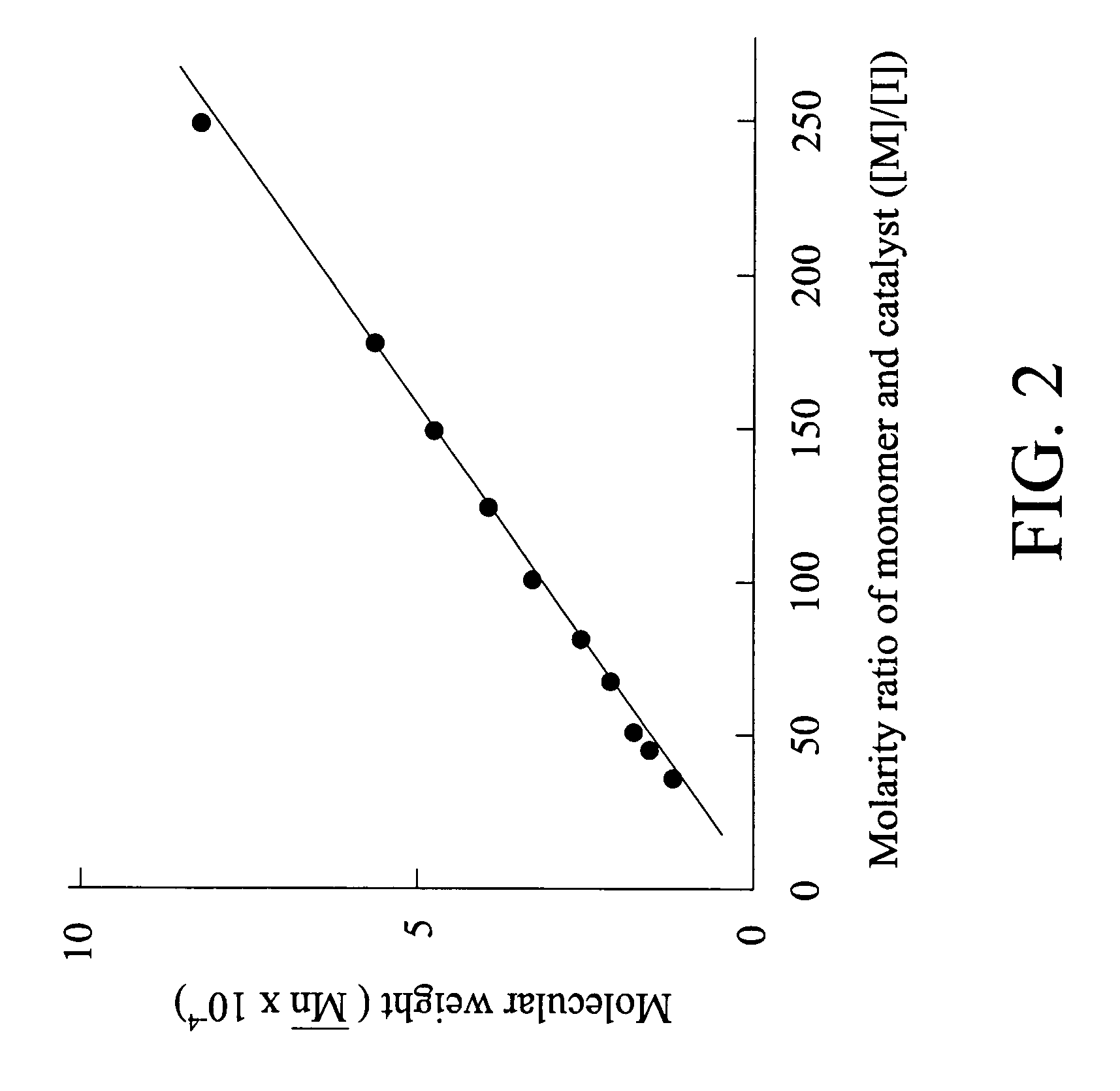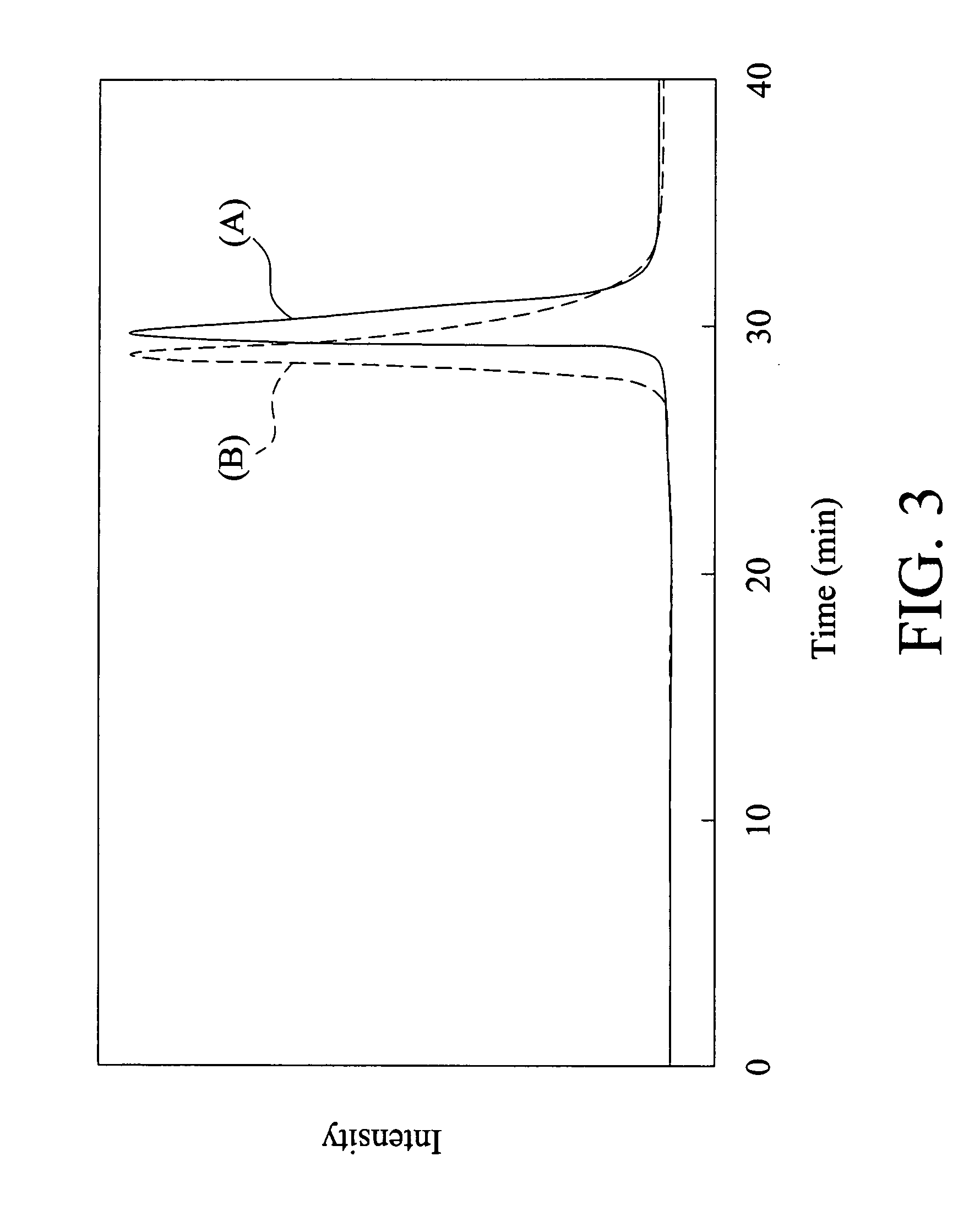Norbornene monomers with fluorene group and polymer material thereof
a technology of fluorene group and monomer, which is applied in the preparation of organic compounds, anthracene dyes, organic dyes, etc., can solve the problems of high polymerization rate of polymerizing polymers, limited use of metathesis polymerization of monomers with poly functional groups, and large molecular weigh
- Summary
- Abstract
- Description
- Claims
- Application Information
AI Technical Summary
Problems solved by technology
Method used
Image
Examples
example 1
[0064]Synthesis of norbornene monomer with terminal fluorene groups (exo-f)
[0065]25 ml of cyclopentadiene, 30.1 ml of methyl acrylate, and 30 ml of dichloromethane were mixed and heated to reflux for 24 hours. The result was added into 5.3 g of Na (dissolved in 80 ml methanol) for 4 hours. Next, the methanol was removed and the remains were dissolved in 50 ml water and heated to reflux, resulting in forcing of the methyl acrylate group to be altered to an acidic group. After acidifying by H2SO4, extraction by ether, and drying by MgSO4, the result was added into 28.8 g sodium bicarbonate (dissolved in 460 ml water) to separate acidified isomers therefrom.
[0066]Next, 25.5 g of iodine, 53.2 g potassium iodide, and 150 ml of water were mixed and added into the above solution. After removing the endo isomer by water extraction, the result was further acidified, crystallized by pentane at −78° C. to obtain exo-b as a yellow crystal.
[0067]Next, 3.5 g of exo-b was dissolved in 150 ml ether...
example 2
[0073]Synthesis of norbornene monomer with side chains of fluorene groups
[0074]First, exo-f was subjected to a vacuum distillation at 115° C. / 4 mmHg to obtain purified exo-f monomer. Next, 0.911 mmol of exo-f was added into 3 ml of THF and degassed fourfold via freeze-pump-thaw cycle. 75 mg of Ru catalyst (RuCl2[C21H26N2][CHC6H5]P(C6H11)3) (dissolved in 0.2 ml of THF) was added and argon was subsequently injected into reactor with a syringe.
[0075]After reacting at 35° C. for 90 seconds, 0.1 ml ethyl vinyl ether was added into the bottle to terminate the reaction. The resulting solution was added to 500 ml of methyl alcohol and the mixture was dissolved in 10 ml of methylene chloride and extracted with 500 methanol three times, thereby obtaining the norbornene monomer with side chains of fluorene groups.
[0076]The glass transition temperature (Tg) of the above norbornene polymer was 80° C. which was determined by differential scanning calorimeter (DSC). The exothermal peak for the gla...
example 3
[0084]Method for modifying the molecular weight of the norbornene polymer by adjusting [M] / [I]
[0085]Example 3 was performed as Example 2 except for substitution of the molarity ratio of NBMGE and Ru catalyst ([M] / [I]) 250 for 40. The molecular weight of the obtained polymer was measured by gel permeation chromatography (GPC) analysis, as shown in FIG. 2. Accordingly, it should be noted that the molecular weight and molecular weight distribution of the polymer with side chains of fluorene group can be modified by adjusting the molarity ratio of the norbornene compound and the catalyst.
[0086]Referring to FIG. 3, the curve (A) illustrated the measurement of the molecular weight of the norbornene polymer with side chains of fluorene group ([M] / [I])=125), and the norbornene polymer has a PDI value of 1.06. It should be noted that the polymerization of Example 3, employing RUCl2[C21H26N2][CHC6H5]P(C6H11)3, has a reaction time of 90 seconds for achieving living polymerization. When the mol...
PUM
| Property | Measurement | Unit |
|---|---|---|
| Time | aaaaa | aaaaa |
| Molecular weight | aaaaa | aaaaa |
| Ratio | aaaaa | aaaaa |
Abstract
Description
Claims
Application Information
 Login to View More
Login to View More - R&D
- Intellectual Property
- Life Sciences
- Materials
- Tech Scout
- Unparalleled Data Quality
- Higher Quality Content
- 60% Fewer Hallucinations
Browse by: Latest US Patents, China's latest patents, Technical Efficacy Thesaurus, Application Domain, Technology Topic, Popular Technical Reports.
© 2025 PatSnap. All rights reserved.Legal|Privacy policy|Modern Slavery Act Transparency Statement|Sitemap|About US| Contact US: help@patsnap.com



